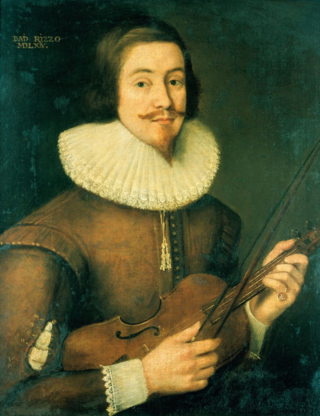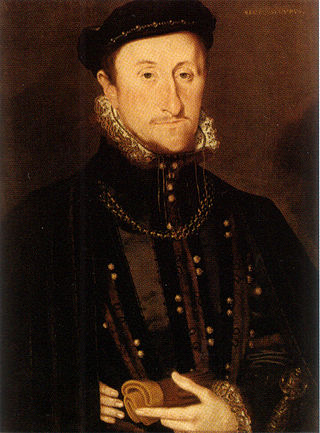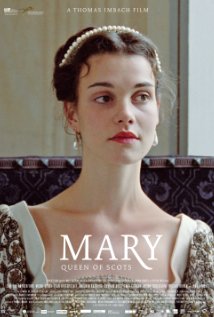
Mary, Queen of Scots, also known as Mary Stuart or Mary I of Scotland, was Queen of Scotland from 14 December 1542 until her forced abdication in 1567.

David Rizzio or Riccio was an Italian courtier, born in Pancalieri close to Turin, a descendant of an ancient and noble family still living in Piedmont, the Riccio Counts di San Paolo e Solbrito, who rose to become the private secretary of Mary, Queen of Scots. Mary's husband, Lord Darnley, is said to have been jealous of their friendship because of rumours that Rizzio had impregnated Mary, and he joined in a conspiracy of Protestant nobles to murder him, led by Patrick Ruthven, 3rd Lord Ruthven. Mary was having dinner with Rizzio and a few ladies-in-waiting when Darnley joined them, accused his wife of adultery and then had a group murder Rizzio, who was hiding behind Mary. Mary was held at gunpoint and Rizzio was stabbed numerous times. His body took 57 dagger wounds. The murder was the catalyst of the downfall of Darnley, and had serious consequences for Mary's subsequent reign.
James Balfour, Lord Pittendreich (c. 1525–1583) was a Scottish legal writer, judge and politician.

Mary, Queen of Scots is a 1971 biographical film based on the life of Mary Stuart, Queen of Scotland, written by John Hale and directed by Charles Jarrott. The cast was led by Vanessa Redgrave as the title character and Glenda Jackson as Elizabeth I. Jackson had previously played the part of Elizabeth in the BBC TV drama Elizabeth R, screened in February and March 1971, the first episode of which was also written by Hale.

James Stewart, 1st Earl of Moray was a member of the House of Stewart as the illegitimate son of King James V of Scotland. At times a supporter of his half-sister Mary, Queen of Scots, he was the regent of Scotland for his half-nephew, the infant King James VI, from 1567 until his assassination in 1570. He was the first head of government to be assassinated with a firearm.

Mary of Scotland is a 1936 American historical drama film starring Katharine Hepburn as the 16th-century ruler Mary, Queen of Scots. Directed by John Ford, it is an adaptation of the 1933 Maxwell Anderson play, with Fredric March reprising the role of Bothwell, which he also performed on stage during the run of play. The screenplay was written by Dudley Nichols. Ginger Rogers wanted to play this role and made a screen test, but RKO rejected her request to be cast in the part feeling that the role was not suitable to her image.
George Gordon, 5th Earl of Huntly, was Lord Chancellor of Scotland and major conspirator of his time.

The Casket letters were eight letters and some sonnets said to have been written by Mary, Queen of Scots, to the Earl of Bothwell, between January and April 1567. They were produced as evidence against Queen Mary by the Scottish lords who opposed her rule. In particular, the text of the letters was taken to imply that Queen Mary colluded with Bothwell in the murder of her husband, Lord Darnley. Mary's contemporary supporters, including Adam Blackwood, dismissed them as complete forgeries or letters written by the Queen's servant Mary Beaton. The authenticity of the letters, now known only by copies, continues to be debated. Some historians argue that they were forgeries concocted in order to discredit Queen Mary and ensure that Queen Elizabeth I supported the kingship of the infant James VI of Scotland, rather than his mother. The historian John Hungerford Pollen, in 1901, by comparing two genuine letters drafted by Mary, presented a subtle argument that the various surviving copies and translations of the casket letters could not be used as evidence of their original authorship by Mary.

The murder of Henry Stuart, Lord Darnley, second husband of Mary, Queen of Scots, took place on 10 February 1567 in Edinburgh, Scotland. Darnley's lodgings were destroyed by gunpowder; his body and that of his servant were found nearby, apparently having been strangled rather than killed in the explosion. Suspicion was placed upon Queen Mary and the Earl of Bothwell, whom Mary went on to marry three months after Darnley's murder. Bothwell was indicted for treason and acquitted, but six of his servants and acquaintances were subsequently arrested, tried, and executed for the crime.
The Battle of Carberry Hill took place on 15 June 1567, near Musselburgh, East Lothian, a few miles east of Edinburgh, Scotland. A number of Scottish lords objected to the rule of Mary, Queen of Scots, after she had married the Earl of Bothwell, who was widely believed to have murdered her previous husband Lord Darnley. The Lords were intent to avenge Darnley's death. However, Bothwell escaped from the stand-off at Carberry while Queen Mary surrendered. Mary abdicated, escaped from prison, and was defeated at the battle of Langside. She went to exile in England while her supporters continued a civil war in Scotland.
Elizabeth Keith, Countess of Huntly, was a Scottish noblewoman and the wife of George Gordon, 4th Earl of Huntly, Scotland's leading Catholic magnate during the reign of Mary, Queen of Scots. In 1562, Elizabeth encouraged her husband to raise forces against Queen Mary which led to his being outlawed, and after his death, his titles forfeited to the Crown. Elizabeth's son Sir John Gordon was executed for having taken part in his father's rebellion.
Janet Beaton, Lady of Branxholme and Buccleugh (1519–1569) was an aristocratic Scottish woman and a mistress of James Hepburn, Earl of Bothwell. She had a total of five husbands. One of her nieces was Mary Beaton, one of the four ladies-in-waiting of Mary, Queen of Scots, known in history as the four Marys. In her lifetime, she was accused of having been a witch. Janet was immortalised as Sir Walter Scott's Wizard Lady of Branxholm in his celebrated narrative poem "Lay of the Last Minstrel".
Anne Hamilton, Countess of Huntly, was a Scottish noblewoman and a member of the powerful Hamilton family which had a strong claim to the Scottish crown. Her father James Hamilton, Duke of Châtellerault, 2nd Earl of Arran was heir presumptive to the throne of Scotland after Mary, Queen of Scots prior to the birth of the latter's son Prince James in 1566. Anne was the wife of George Gordon, 5th Earl of Huntly, Lord Chancellor of Scotland and a chief conspirator during the reign of Queen Mary.

Jean Hepburn, Lady Darnley, Mistress of Caithness, Lady Morham was a Scottish noblewoman and a member of the Border clan of Hepburn. Her brother was James Hepburn, Earl of Bothwell, the third husband of Mary, Queen of Scots. Jean's first husband was John Stewart, 1st Lord Darnley, an illegitimate half-brother of Queen Mary, which made Jean a double sister-in-law of the queen. Jean married three times. She was also Lady of Morham, having received in 1573 the barony of Morham and lands which had belonged to her mother, Lady Agnes Sinclair and was forfeited to the Crown subsequent to her brother, the Earl of Bothwell's attainder for treason.
Das Herz der Königin is a 1940 German historical film, making selective use of the life story of Mary, Queen of Scots, and her execution by Queen Elizabeth I for anti-English and pro-Scottish propaganda, in the context of the Second World War going on at the time.

The Ainslie Tavern Bond was a document signed on about 20 April 1567 by a number of Scottish bishops and nobles. The bond approved the Earl of Bothwell's acquittal on 12 April of implication in the murder of Lord Darnley, recommended him as an appropriate husband for Mary, Queen of Scots, and pledged to assist in defending such a marriage.

Mary Queen of Scots is a 2013 Swiss period drama directed and co-written by Thomas Imbach. It is his first film in the English and French languages, starring the bilingual French actress Camille Rutherford. The film portrays the inner life of Mary, the Queen of Scotland. The film is based on the Austrian novelist Stefan Zweig's 1935 biography, Mary Stuart, a long-term bestseller in Germany and France but out of print in the UK and the US for decades until 2010. The film was first screened at the 2013 International Film Festival Locarno and was later shown at the 2013 Toronto International Film Festival.

Mary Queen of Scots is a 2018 historical drama film directed by Josie Rourke and with a screenplay by Beau Willimon based on John Guy's 2004 biography Queen of Scots: The True Life of Mary Stuart. The film stars Saoirse Ronan as Mary, Queen of Scots, and Margot Robbie as her cousin Queen Elizabeth I. Jack Lowden, Joe Alwyn, David Tennant, and Guy Pearce also star in supporting roles.
Margaret Beaton, Lady Reres was a Scottish courtier and companion of Mary of Guise and Mary, Queen of Scots. She was blamed by the enemies of Mary, Queen of Scots, for her involvement in alleged immorality at court.
Arthur Erskine of Blackgrange was a Scottish courtier.












